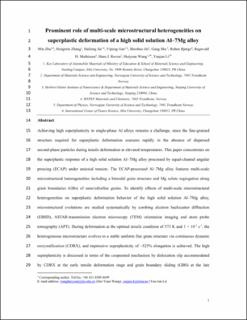| dc.contributor.author | Zha, Min | |
| dc.contributor.author | Zhang, Hongmin | |
| dc.contributor.author | Jia, Hailong | |
| dc.contributor.author | Gao, Yipeng | |
| dc.contributor.author | Jin, Shenbao | |
| dc.contributor.author | Sha, Gang | |
| dc.contributor.author | Bjørge, Ruben | |
| dc.contributor.author | Mathiesen, Ragnvald | |
| dc.contributor.author | Roven, Hans Jørgen | |
| dc.contributor.author | Wang, Hui-Yuan | |
| dc.contributor.author | Li, Yanjun | |
| dc.date.accessioned | 2022-03-10T12:57:21Z | |
| dc.date.available | 2022-03-10T12:57:21Z | |
| dc.date.created | 2021-09-28T20:46:10Z | |
| dc.date.issued | 2021 | |
| dc.identifier.citation | International journal of plasticity. 2021, 146 . | en_US |
| dc.identifier.issn | 0749-6419 | |
| dc.identifier.uri | https://hdl.handle.net/11250/2984292 | |
| dc.description.abstract | Achieving high superplasticity in single-phase Al alloys remains a challenge, since the fine-grained structure required for superplastic deformation coarsens rapidly in the absence of dispersed second-phase particles during tensile deformation at elevated temperatures. This paper concentrates on the superplastic response of a high solid solution Al–7Mg alloy processed by equal-channel angular pressing (ECAP) under uniaxial tension. The ECAP-processed Al–7Mg alloy features multi-scale microstructural heterogeneities including a bimodal grain structure and Mg solute segregation along grain boundaries (GBs) of nano/ultrafine grains. To identify effects of multi-scale microstructural heterogeneities on superplastic deformation behavior of the high solid solution Al–7Mg alloy, microstructural evolutions are studied systematically by combing electron backscatter diffraction (EBSD), ASTAR-transmission electron microscopy (TEM) orientation imaging and atom probe tomography (APT). During deformation at the optimal tensile condition of 573 K and 1 × 10−3 s−1, the heterogeneous microstructure evolves to a stable uniform fine grain structure via continuous dynamic recrystallization (CDRX), and impressive superplasticity of ∼523% elongation is achieved. The high superplasticity is discussed in terms of the cooperated mechanism by dislocation slip accommodated by CDRX at the early tensile deformation stage and grain boundary sliding (GBS) at the late deformation stage. Our findings show that the evolution of microstructural heterogeneities in high solid solution Al–Mg alloys can be regulated, favoring for superplastic deformation, which offers an alternative strategy for developing low-cost Al alloys for enhanced mechanical properties. | en_US |
| dc.language.iso | eng | en_US |
| dc.publisher | Elsevier | en_US |
| dc.rights | Attribution-NonCommercial-NoDerivatives 4.0 Internasjonal | * |
| dc.rights.uri | http://creativecommons.org/licenses/by-nc-nd/4.0/deed.no | * |
| dc.title | Prominent role of multi-scale microstructural heterogeneities on superplastic deformation of a high solid solution Al–7Mg alloy | en_US |
| dc.type | Peer reviewed | en_US |
| dc.type | Journal article | en_US |
| dc.description.version | acceptedVersion | en_US |
| dc.rights.holder | This is the authors' accepted manuscript to an article published by Elsevier. Locked until 5.9.2023 due to copyright restrictions. | en_US |
| dc.source.pagenumber | 18 | en_US |
| dc.source.volume | 146 | en_US |
| dc.source.journal | International journal of plasticity | en_US |
| dc.identifier.doi | 10.1016/j.ijplas.2021.103108 | |
| dc.identifier.cristin | 1940141 | |
| cristin.ispublished | true | |
| cristin.fulltext | postprint | |
| cristin.qualitycode | 2 | |

